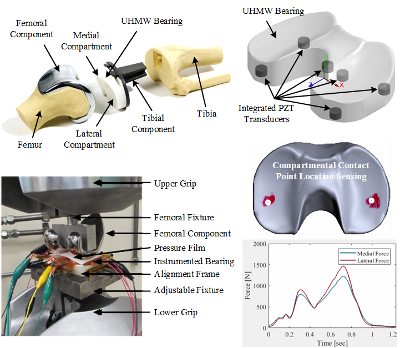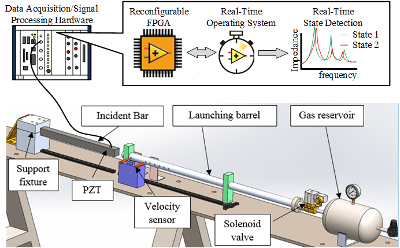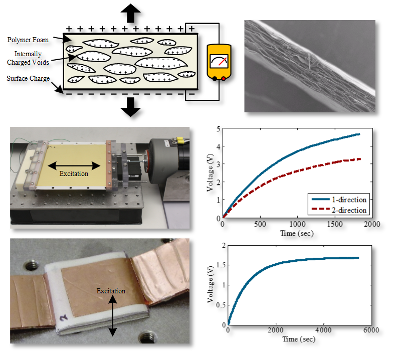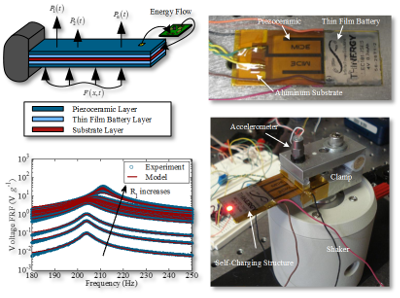Integrated Load and Wear Sensing in Total Knee Replacements
Each year, over 700,000 patients receive total knee replacements in the US, however, a recent study shows that only eighty percent of patients are satisfied with their level of pain and function after surgery. Furthermore, over 60,000 revision knee arthroplasties are performed annually in the US with the leading non-infectious cause being instability in the joint. Current surgical practices for balance of ligamentous forces in total knee arthroplasty rely heavily on the experience of the surgeon and their interpretation of the tactile “feel” of a balanced knee. Determining the ideal ligamentous balance of forces between the medial and lateral compartments of a knee during implantation of knee prosthesis is essential to its success and is considered by many orthopedic surgeons the Holy Grail, as it is currently not well understood. The critical barrier preventing progress in this understanding is the lack of continuous postoperative measurement of compartmental knee forces that will allow insight into the distribution of forces during and after the healing process and correlation of the force distribution to patient function and outcome. Identification of the ideal ligamentous balance can allow a transformation from qualitative, experience-driven surgical practices to quantitative, data-driven procedures. Additionally, knowledge of the knee forces throughout the life of the implant can aid in the design of next generation implants that are more robust against early wear and failure. The goal of this research is to study the preclinical development and testing of a self-sensing and self-powered total knee replacement (TKR) that embeds piezoelectric transducers inside the polyethylene bearing of a TKR unit for load sensing of tibiofemoral forces and generation of electrical energy to power the device.
Related Publications
Journal Articles
- Safaei, M., Dupre, S., Hoummadi, E., and Anton, S. R., 2019, Design, Analysis, and Fabrication of a Piezoelectric Force Tray for Total Knee Replacements, Journal of Intelligent Material Systems and Structures, Vol. 30, No. 20, pp. 3163-3176. (Copyright by Sage Publications)
- Ponder, R. I., Safaei, M., and Anton, S. R., 2019, Fabrication and Selection of Surrogate Knee Implant Bearings for Experimental Evaluation of Embedded In-Vivo Sensors, Journal of the Mechanical Behavior of Biomedical Materials, Vol. 91, pp. 237-246. (Copyright by Elsevier)
- Safaei, M., Meneghini, R. M., and Anton, S. R., 2018, Force Detection, Center of Pressure Tracking, and Energy Harvesting from a Piezoelectric Knee Implant, Smart Materials and Structures, Vol. 27, No 11, 114007 (13 pp.). (Copyright by IOP Publishing)
- Safaei, M., Meneghini, R. M., and Anton, S. R., 2018, Energy Harvesting and Sensing with Embedded Piezoelectric Ceramics in Knee Implants, IEEE/ASME Transactions on Mechatronics, Vol. 23, No 2, pp. 864-874. (Copyright by IEEE)
- Safaei, M., Meneghini, R. M., and Anton, S. R., 2017, Parametric Analysis of Electromechanical and Fatigue Performance of Total Knee Replacement Bearing with Embedded Piezoelectric Transducers, Smart Materials and Structures, Vol. 26, No 9, 094002 (15 pp.). (Copyright by IOP Publishing)
Conference Papers
- Ghattas, N. W., Ponder, R. I., and Anton, S. R., Investigation of Mechanical Boundary Conditions on Impedance Based Structural Health Monitoring in a Biomedical Environment, Proc. SPIE, 2019, Vol. 10972, 1097228 (11 pp.).
- Ponder, R. I., Meneghini, R. M., and Anton, S. R., Evaluation of Electromechanical Impedance Based Structural Health Monitoring for Detection of Loosening in Total Knee Arthroplasty, Proc. SPIE, 2019, Vo. 10972, 1097226 (11 pp.).
- Ponder, R. I., Roberts, H. R., Safaei, M., and Anton, S. R., Feasibility of Force Detection in 3D Printed Flexible Materials using Embedded Sensors, Proc. SPIE, 2019, Vo. 10970, 109702F (12 pp.).
- Carlson, J., Tiberi, Z., Safaei, M., Ponder, R. I., and Anton, S. R., Parametric Testing of Surrogate Knee Replacement Bearings with Embedded Piezoelectric Transducers, Proc. ASME SMASIS, 2018, SMASIS2018-8037 (9 pp.).
- Ponder, R. I., Safaei, M., and Anton, S. R., Validation of Impedance-Based Structural Health Monitoring in a Simulated Biomedical Implant System, Proc. ASME SMASIS, 2018, SMASIS2018-8012 (8 pp.).
- Safaei, M. and Anton, S. R., Self-powered Multifunctional Instrumented Knee Implant, Proc. ASME SMASIS, 2018, SMASIS2018-8078 (11 pp.).
- Safaei, M., Ponder, R. I., and Anton, S. R., Detection of Compartmental Forces and Location of Contact Areas with Piezoelectric Transducers in Total Knee Arthroplasty, Proc. SPIE, 2018, Vol. 10595, 105951Q (10 pp.).
- Ponder, R. I., Safaei, M., and Anton, S. R., Development of Surrogate Biomedical Knee Implants for Validation of Embedded Smart Sensors, Proc. ASME SMASIS, 2017, SMASIS2017-3879 (7 pp.).
- Safaei, M. and Anton, S. R., Experimental Evaluation of Sensing and Energy Harvesting Behavior of Implanted Piezoelectric Transducers in Total Knee Replacement, Proc. ASME SMASIS, 2017, SMASIS2017-3881 (8 pp.).
- Hoummadi, E., Safaei, M., and Anton, S. R., Design, Analysis, and Fabrication of a Piezoelectric Force Plate, Proc. SPIE, 2017, Vol. 10170, 101700W (11 pp.).
- Safaei, M. and Anton, S. R., Analytical and Finite Element Performance Evaluation of Embedded Piezoelectric Sensors in Polyethylene, Proc. SPIE, 2017, Vol. 10172, 101720I (12 pp.).
- Safaei, M. and Anton, S. R., Sensing and Energy Harvesting Performance, and Fatigue Life of Embedded Piezoelectric Transducer in Total Knee Arthroplasty, Proc. ASME SMASIS, 2016, SMASIS2016-9216 (11 pp.).
- Safaei, M. and Anton, S. R., The Effects of Dimensional Parameters on Sensing and Energy Harvesting of an Embedded PZT in a Total Knee Replacement, Proc. SPIE, 2016, Vol, 9799, 97992P (13 pp.).
- Contreras, C. E., Parkison, A. E., Wilson, B. E., Meneghini, R. M., and Anton, S. R., Geometric Effects on Embedded Piezoelectric Energy Harvester in Knee Replacement Bearing, Proc. ASME SMASIS, 2015, SMASIS2015-9063 (11 pp.).
- Wilson, B. E., Meneghini, R. M., and Anton, S. R., Embedded Piezoelectrics for Sensing and Energy Harvesting in Total Knee Replacement Units, Proc. SPIE, 2015, Vol. 9431, 943111E (10 pp.).
- Wilson, B. E., Anton, S. R.,and Meneghini, R. M., Development of Biomechanical Knee Force Model for Evaluation of Piezoelectric Sensors for In-Vivo Monitoring, Proc. ASME SMASIS, 2014, SMASIS2014-7692 (5 pp.).
Real-Time State Monitoring in Highly Dynamic Environments
Current state-of-the-art in real-time structural health monitoring (SHM) systems allows for continuous measurement of slowly changing structures on the order of seconds to minutes. This is adequate for conventional application of SHM on structures experiencing incipient damage, such as fatigue cracking and corrosion, however, there is a need to advance SHM technology for structures operating in highly dynamic environments (e.g. shock, blast, high-velocity impact, etc.) such that changes can be detected on the microsecond to millisecond timescale. The goal of this research is to close this gap in scientific knowledge through the development of continuous, real-time state detection systems for use in extreme dynamic environments. In our current work, conventional electromechanical impedance-based SHM concepts are being extended to structural systems experiencing rapid changes in state (e.g. boundary conditions, interfaces, structural damage, etc.). Critical areas of research involved in the development of this technology include the extension of impedance techniques into the MHz frequency range to allow faster interrogation of structures, the development of time-efficient data collection strategies, the development of signal processing methods to minimize the amount of data that must be handled, and the creation of time-efficient state detection and quantification algorithms. In an effort to achieve these goals, this work leverages real-time operating systems (RTOSs) in conjunction with field programmable gate array (FPGA) technology for fast and deterministic data acquisition, signal compression, and state detection algorithm deployment.
Related Publications
Conference Papers
- Nolan, E. C., Safaei, M., and Anton, S. R., Evaluation of SHM with the Electromechanical Impedance Method using a High Voltage Excitation Signal in High Frequencies, Proc. ASME SMASIS, 2019, SMASIS2019-5556 (9 pp.).
- Safaei, M., Nolan, E. C., and Anton, S. R., Finite Element Evaluation of EMI-Based Structural Health Monitoring in High Frequencies, Proc. SPIE, 2019, Vol. 10972, 109720C (12 pp.).
- Ehite E. H. and Anton, S. R., A Low-Cost Modular Impact-Based Experimental Setup for Evaluation of EMI Based Structural Health Monitoring at High Rates, Proc. SEM IMAC, 2018, (10 pp.).
- Kettle, R. A. and Anton, S. R., Multi-tonal Based Impedance Measurements for Microsecond State Detection, Proc. SEM IMAC, 2018, (7 pp.).
- Kettle, R. A., Ehite, E. H., and Anton, S. R., Development of an Electromechanical Impedance Based Condition Monitoring System with Multi-Tonal Excitation, Proc. Vibration Institute Annual Conference, 2017, (18 pp.).
- Kettle, R. A., Dodson, J. C., and Anton, S. R., High Frequency Impedance Measurements for Microsecond State Detection, Proc. SEM IMAC, 2017 (9 pp.).
- Kettle, R. A. and Anton, S. R., Rapid Evaluation of Mechanical Boundary Conditions using Impedance Based Structural Health Monitoring, Proc. SPIE, 2016, Vol. 9805, 98051S (13 pp.).
- Kettle, R. A., Dick, A. J., Dodson, J. C., Foley, J. R., and Anton, S. R., Real-Time State Detection in Highly Dynamic Systems, Proc. SEM IMAC, 2016 (9 pp.).
Piezoelectret Foam for Lightweight, Flexible, Lead-Free Vibration Energy Harvesting
Cellular ferroelectret polymers, also called piezoelectret foam, present a flexible, lightweight, lead-free alternative to the widely popular piezoelectric ceramics (PZT, BaTiO2, etc.) used today. Piezoelectret foams are a class of electret material, a dielectric material that contains permanent electric charge or polarization analogous to the magnetic fields found in permanent magnets. Piezoelectricity is observed in piezoelectrets due to the deposition of charge on internal voids in the structure. When subject to mechanical or electrical stimuli, the charged voids respond as macroscopic dipoles, thus yielding piezoelectric-like properties. Piezoelectret foams have been used in sensing applications for some time, but present a novel material for energy harvesting purposes. The goal of this work is to perform an in-depth analysis of piezoelectret foam for vibration-based energy harvesting combining electromechanical modeling and experimentation to further the understanding of the behavior of this material. We are interested in investigation of both single-layer and multilayer stack configurations.
Related Publications
Journal Articles
- Ray, C. A. and Anton, S. R., 2017, Multilayer Piezoelectret Foam Stack for Vibration Energy Harvesting, Journal of Intelligent Material Systems and Structures, Vol. 28, No. 3, pp. 408-420. (Copyright by SAGE Publications)
- Anton, S. R., Erturk, A., and Farinholt, K. M., 2014, Piezoelectret Foam-Based Vibration Energy Harvesting, Journal of Intelligent Material Systems and Structures, Vol. 25, No 14, pp. 1681-1692. (Copyright by SAGE Publications)
Conference Papers
- Tefft, E. C. and Anton, S. R., A Multiple Degree of Freedom Model of Piezoelectret Foam in an Updated Multilayer Stack Configuration, Proc. SPIE, 2017, Vol. 10164, 1016404 (13 pp.).
- Tefft, E. C., and Anton, S. R., A Multiple Degree of Freedom Modeling Approach of Piezoelectret Foam in a Multilayer Stack Configuration, Proc. SPIE, 2016, Vol. 9799, 97991P (12 pp.).
- Ray, C. A. and Anton, S. R., Evaluation of Piezoelectret Foam in a Multilayer Stack Configuration for Low-Level Vibration Energy Harvesting Applications, Proc. SPIE, 2015, Vol. 9431, 943111 (11 pp.).
- Anton, S. R. and Farinholt, K. M., Piezoelectret Foam-Based Vibration Energy Harvester for Low-Power Energy Generation, Proc. ASME SMASIS, 2012, SMASIS2012-8224 (9 pp.).
- Anton, S. R. and Farinholt, K. M., An Evaluation on Low-Level Energy Harvesting using Piezoelectret Foam, Proc. SPIE, 2012, Vol. 8341, 83410G-10 (10 pp.).
Multifunctional Self-Charging Structures for Simultaneous Energy Harvesting and Storage
Multifunctional energy harvesting aims to improve the functionality and address the challenges associated with conventional piezoelectric energy harvesting in which the system is designed to be added to a host structure, often causing undesirable mass loading effects and consuming valuable space. The goal of this work is to develop a piezoelectric vibration-based energy harvesting approach in which a single device can generate and store electrical energy and also carry structural loads. The proposed self-charging structures contain both power generation and energy storage capabilities in a multilayered, composite platform consisting of active piezoelectric layers for scavenging energy, thin-film battery layers for storing scavenged energy, and a central metallic substrate layer. The operational principle behind the device involves simultaneous generation of electrical energy in the piezoelectric layers when subjected to dynamic loading causing deformations in the structure, as well as energy storage in the thin-film battery layers. Energy is transferred directly from the piezoelectric layers through appropriate conditioning circuitry to the thin-film battery layers, thus a single device is capable of both generating and storing electrical energy. Additionally, self-charging structures are capable of carrying loads as structural members when embedded into a host system due to the stiffness of the composite device. The ability of the device to harvest energy, store energy, and support structural loads provides true multifunctionality.
Related Publications
Journal Articles
- Anton, S. R., Erturk, A., and Inman, D. J., 2012, Bending Strength of Piezoelectric Ceramics and Single Crystals for Multifunctional Load-Bearing Applications, IEEE Transactions on Ultrasonics, Ferroelectrics, and Frequency Control, Vol. 59, No 6, pp. 1085-1092. (Copyright by IEEE)
- Anton, S. R., Erturk, A., and Inman, D. J., 2012, Multifunctional Unmanned Aerial Vehicle Wing Spar for Low-Power Generation and Storage, AIAA Journal of Aircraft, Vol. 49, No 1, pp. 292-301. (Copyright by AIAA)
- Gambier, P., Anton, S. R., Kong, N., Erturk, A., and Inman, D. J., 2012, Piezoelectric, Solar and Thermal Energy Harvesting for Hybrid Low-Power Generator Systems with Thin-Film Batteries, Measurement Science and Technology, Vol. 23, No 1, 015101 (11 pp.). (Copyright by IOP Publishing)
- Anton, S. R., Erturk, A., and Inman, D. J., 2010, Multifunctional Self-Charging Structures using Piezoceramics and Thin-Film Batteries, Smart Materials and Structures, Vol. 19, No 11, 115021 (15 pp.). (Copyright by IOP Publishing)




